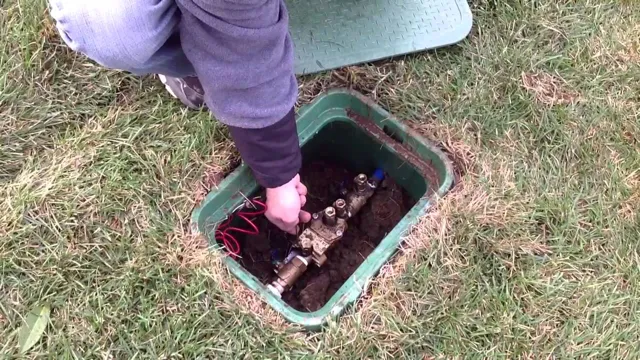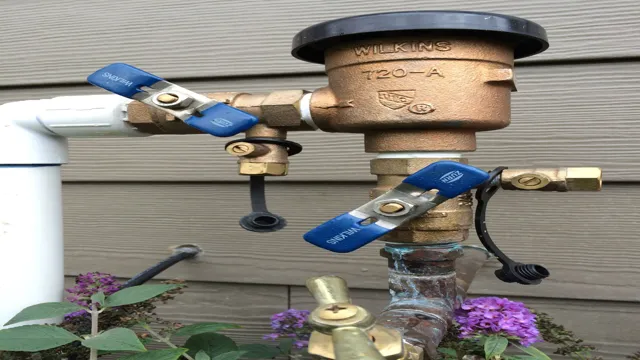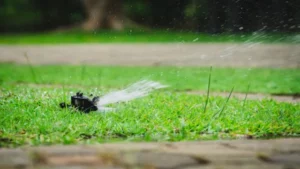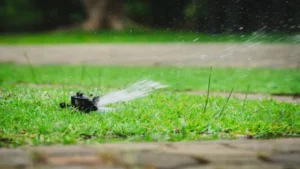If you’re a homeowner with a sprinkler system, you know how important it is to keep your lawn looking lush and green during the hot summer months. But what happens when you go to turn on your sprinkler system and nothing happens? Don’t worry, you’re not alone! Turning on a sprinkler system’s water can be confusing, especially if you’re new to sprinkler systems or you’re not familiar with the setup of your particular system. However, with a little knowledge and some easy steps, you can have your sprinkler system up and running in no time! In this blog, we’ll guide you through the process of turning on your sprinkler system’s water, from locating your main water valve to inspecting your system for any damage.
We’ll also provide some helpful tips and tricks for maintaining your sprinkler system throughout the year, ensuring that your lawn stays healthy and well-watered. So, let’s get started!
Locate the Water Main
If you’re trying to turn on your sprinkler system for the first time, the first step is to locate the water main. This is where the main water supply enters your house, and it’s usually located outside near the street. You should look for a small metal lid or box that says “water main” or “shut-off valve.
” Once you find it, use a wrench to turn the valve counterclockwise to open it. This will allow water to flow into your sprinkler system. Be careful not to turn it too far, or you could end up causing damage to your pipes or sprinkler system.
Remember that if you ever need to turn off your water quickly, you can always go back to this valve and turn it clockwise to shut off the water supply.
Check Near Your Home’s Foundation or Sidewalk
When it comes to finding the water main near your home’s foundation or sidewalk, it’s important to know where to look. Often, the water main will be located near the street, but it can also be located closer to your home or even in your yard. The best way to locate the water main is to look for the water meter, which is typically located near the main shut-off valve.
This shut-off valve is important because it allows you to turn off the water supply to your home in the event of an emergency or needed repair. Once you have located the main shut-off valve, you can then trace the water main back to its source. It’s important to know where the water main is located so that you can easily access it in case of emergencies or necessary repairs.
Keep in mind that water mains can be made of a variety of materials, including copper, iron, and PVC, so it’s important to know what type of material you are dealing with when making repairs or upgrades. By knowing where your water main is located, you can ensure that your home’s water supply is reliable and functioning properly.

Look for a Valve Box
When it comes to locating the water main of your property, the first thing you should do is look for a valve box. This is where the water shut-off valve is located and can typically be found near the edge of your property or where the main water line enters your home. The valve box may be buried underground, so look for a round or rectangular lid that can be lifted off.
Once you locate the valve box, use a water meter key to open it and turn off the water supply. This is important if you need to do any plumbing repairs or maintenance. By knowing how to locate your water main, you’ll save yourself time and frustration in the long run, and be able to quickly shut off the water in case of an emergency.
Switch On the Water Supply
When it comes to turning on your sprinkler system, the first step is to switch on the water supply. This is typically done at the main water valve for your home. If you are unsure where this valve is located, check near your water meter or contact your local water department for assistance.
Once you have located the valve, turn it counterclockwise to open the valve and allow water to flow to your sprinkler system. Keep in mind that it is important to check your sprinkler system for any leaks or damages before turning on the water supply, as this can cause further damage to your system. By taking the time to properly turn on your water supply, you can ensure that your sprinkler system is functioning properly and efficiently.
Turn the Valve Handle to the Right
Switching on the water supply can be a straightforward process, but sometimes it can be hard to know where to start. First and foremost, locate the valve handle that controls water flow – it’s usually near the water meter or the main water line. Once you’ve found it, turn the valve handle to the right.
This will allow water to flow freely through the pipes and into your home. It’s important to remember that the water supply is a precious resource that should be used wisely, so don’t forget to turn off the valve when you’re finished using the water. One analogy that might be helpful is to think of the valve handle as a faucet in your sink – turn it on when you need water, but don’t forget to turn it off when you’re done.
By taking care of your water supply, you can ensure that it will be available whenever you need it. So, the next time you need to switch on the water supply, remember to turn the valve handle to the right and enjoy the benefits of a steady, reliable water supply.
Listen for Water Flowing Through the Pipes
If you’re dealing with low water pressure or experiencing weird noises coming from your pipes, it might be time to listen for water flowing through the pipes. Start by turning on the water supply and go to the lowest level of your home to listen to the pipes. You’ll want to listen for the sound of running water or even hissing sounds.
These sounds could indicate that there’s a leak somewhere, and it’s important to locate the source of the problem before it gets worse. By regularly listening for water flow, you can spot potential issues early on and avoid costly repairs down the line. Don’t wait until it’s too late – take a few minutes each month to listen for water flowing through the pipes and keep your plumbing system running smoothly.
Check for Leaks or Obstructions
After installing a new faucet, you’ll need to turn on the water supply to check for any leaks or obstructions. To do this, you’ll need to locate the water shut-off valve and turn it back on slowly to avoid any sudden pressure changes. Once the water is back on, check for any leaks around the base of the faucet, as well as any dripping from the spout or handles.
If you notice any leaks, tighten the connections or replace any damaged parts. You should also run the water for a few minutes to flush out any debris that may be causing an obstruction. This will ensure your new faucet is working properly and will last for many years to come.
Remember, always check for leaks before using your new faucet to avoid any water damage to your home.
Turn On the Controller
If you’re a homeowner with a sprinkler system, you know how important it is to properly turn your system on come springtime. To turn on the water for your sprinkler system, you’ll first need to locate your controller. Your controller is usually located in your garage or another indoor location, and it’s the brains of your system.
Once you’ve located your controller, make sure it’s set to “off” before proceeding. Then, turn on the water supply valve to your sprinkler system. While you’re at it, make sure that your main water shut off valve is on as well.
Lastly, turn the controller to the “on” position and program it to your desired watering schedule. It’s a good idea to double-check that everything is working properly by walking around your property and making sure all zones are properly watering. If you run into any issues, don’t hesitate to call a professional for assistance.
Overall, turning on your sprinkler system can be a quick and easy task that ensures your lawn and garden stays healthy all season long.
Set the Controller to ‘Run’ or ‘Auto’
To get your equipment running, you’ll need to turn on the controller, and that means setting it to “Run” or “Auto.” Don’t worry if you’re not sure how to do this; it’s a straightforward process. Just locate the controller’s power switch and set it to the “On” position.
Then, check that the mode selector switch is set to “Run” or “Auto,” depending on the type of controller you’re using. The “Run” mode will keep the equipment running constantly, while the “Auto” mode will turn the equipment on and off automatically, based on preset parameters, to conserve energy. Always remember to refer to your equipment manual for specific instructions on setting up your controller.
Select the Desired Watering Schedule
Once you’ve selected the desired watering schedule for your lawn or garden, it’s time to turn on the controller. This step is crucial in ensuring that your plants receive the necessary amount of water at the right time. Most controllers have a manual mode that allows you to activate the system and test the sprinklers.
To turn on the controller, locate the power button and press it. Some controllers may require a specific sequence of buttons to activate, so be sure to consult your instructions manual if you’re unsure. Once the controller is turned on, you can begin to adjust the settings to your liking.
Remember to regularly check the system and make any necessary adjustments, such as changing the watering schedule to accommodate changing weather conditions. By turning on the controller and keeping a watchful eye on your lawn or garden, you can enjoy healthy, thriving plants all season long.
Keep Your Sprinkler System Running Smoothly
If you’re looking to keep your sprinkler system running smoothly, it’s important to know how to turn the water on. First, locate the main water shut-off valve for your home. This is typically located near the water meter or in the basement.
Once you’ve found it, turn the valve clockwise to shut off the water supply. From there, locate the sprinkler system’s backflow prevention device and turn the valves on either side to the open position. Finally, slowly turn the main water valve counterclockwise to gradually let water flow into the system.
Making sure your sprinkler system has enough water is crucial for proper functioning and a healthy lawn.
Conclusion
In conclusion, turning on your sprinkler system’s water supply is a straightforward task that can be accomplished with ease. It’s as easy as ABC: A) Locate the valve, B) turn the valve to the “on” position, and C) sit back and watch your lawn transform into a verdant paradise. So don’t let a dry lawn get you down, follow these simple steps and let the water flow!”
FAQs
How do I turn on my sprinkler system?
To turn on your sprinkler system, locate the main water valve for the system and turn it on. This valve is typically located near the water meter or in a valve box near the sprinkler system.
What if my sprinkler system doesn’t turn on?
If your sprinkler system doesn’t turn on, first check that the water valve is fully open. If that doesn’t work, check for any clogs in the sprinkler heads or damaged valves that may need to be replaced.
Can I use a timer to automatically turn on my sprinkler system?
Yes, you can use a timer to automatically turn on your sprinkler system at set times throughout the week. Simply connect the timer to the main water valve and set the desired watering schedule.
How often should I water my lawn using the sprinkler system?
The frequency of watering will depend on several factors, including the type of grass, climate, and soil conditions. In general, lawns should be watered deeply once or twice a week rather than frequent shallow waterings.
Can I manually control the sprinkler heads to water specific areas of my lawn?
Yes, most sprinkler systems allow for individual control of the sprinkler heads, allowing you to water specific areas of your lawn or garden as needed.
What should I do to prepare my sprinkler system for winter?
To prepare your sprinkler system for winter, first turn off the water supply and drain the system of any remaining water. Then, insulate any exposed pipes or valves to prevent freezing and damage during the winter months.
How do I maintain my sprinkler system?
Regular maintenance of your sprinkler system can help prevent leaks, clogs, and other issues. This includes checking for damaged or clogged heads, adjusting water pressure, and ensuring proper sprinkler coverage.






